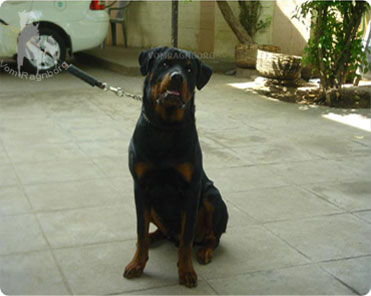Breed Standard
|
Buying a Rottweiler
|
Charts
|
Rotty Care
|
Helath Concerns
|
Our Favorite Rottweilers

The breed is an ancient one and its history stretches back to the Roman Empire.This drover dog has been described by various accredited sources as having been of the Mastiff-type-a dependable, rugged, willing worker, possessed of great intelligence, and a strong guarding instinct. The transition from Roman herding dog to the dog we know today as the Rottweiler can be attributed to the ambitions of the Roman Emperors to conquer Europe. Very large armies were required for these expeditions and the logistics of feeding that number of men became a major consideration. No means of refrigeration existed which meant that the meat for the soldiers had to accompany the troops "on the hoof." The services of a dog capable of keeping the herd intact during the long march were needed. The above-described "Mastiff-type" was admirably suited to both that job and the additional responsibility of guarding the supply dumps at night. In those times the legions travelled with their meat on the hoof and required the assistance of working dogs to herd the cattle. One of the routes the army travelled was through Wüberg and on to the small market town of Rottweil.
This region eventually became an important cattle area and the descendants of the Roman cattle dogs proved their worth in both droving and protecting the cattlemen from robbers. It would be a brave villain who would try and remove the purse around the neck of a Rottweiler Metzgershund (Butcher's Dog of Rottweil).
The descendants of the Roman drover dog plied their trade without interruption until the middle of the 19th century, at which time the driving of cattle was outlawed; in addition, the donkey and the railroad replaced the dog cart.
The Rottweiler Metzgerhund (butcher dog),then fell on hard times. His function had been severely curtailed and in those days, dogs earned their keep or there was no reason for their existence. The number of Rottweilers declined so radically that in 1882 the dog show in Heilbronn, Germany reported just one poor example of the breed present.
The annals of cynology make no further mention of the breed until 1901 when a combined Rottweiler and Leonberger Club was formed. This Club was shortlived but notable because the first Rottweiler standard appeared under its auspices. It is of value for us to know that the general type advocated has not changed substantially and the character called for, not at all.
But the build up to the First World War saw a great demand for "police dogs" and that led to a revival in interest for the Rottweiler. Its enormous strength, its intelligence, and its ability to take orders made it a natural weapon of war In these years (1901-07) the Rottweiler again found favor as a police dog. Several clubs were organized as dissension was most common until 1921 when it was agreed to form the Allegmeiner Deutscher Rottweiler Klub (ADRK). By that time, 3,400 Rottweilers had been registered by three or four clubs. Duplications and confusion ended when the ADRK published its first stud book in 1924.
Since its inception, despite the difficulties encountered during and in the aftermath of World War II, the ADRK has remained intact and through its leadership enlightened, purposeful breeding programs have been promoted both in Germany and abroad.
